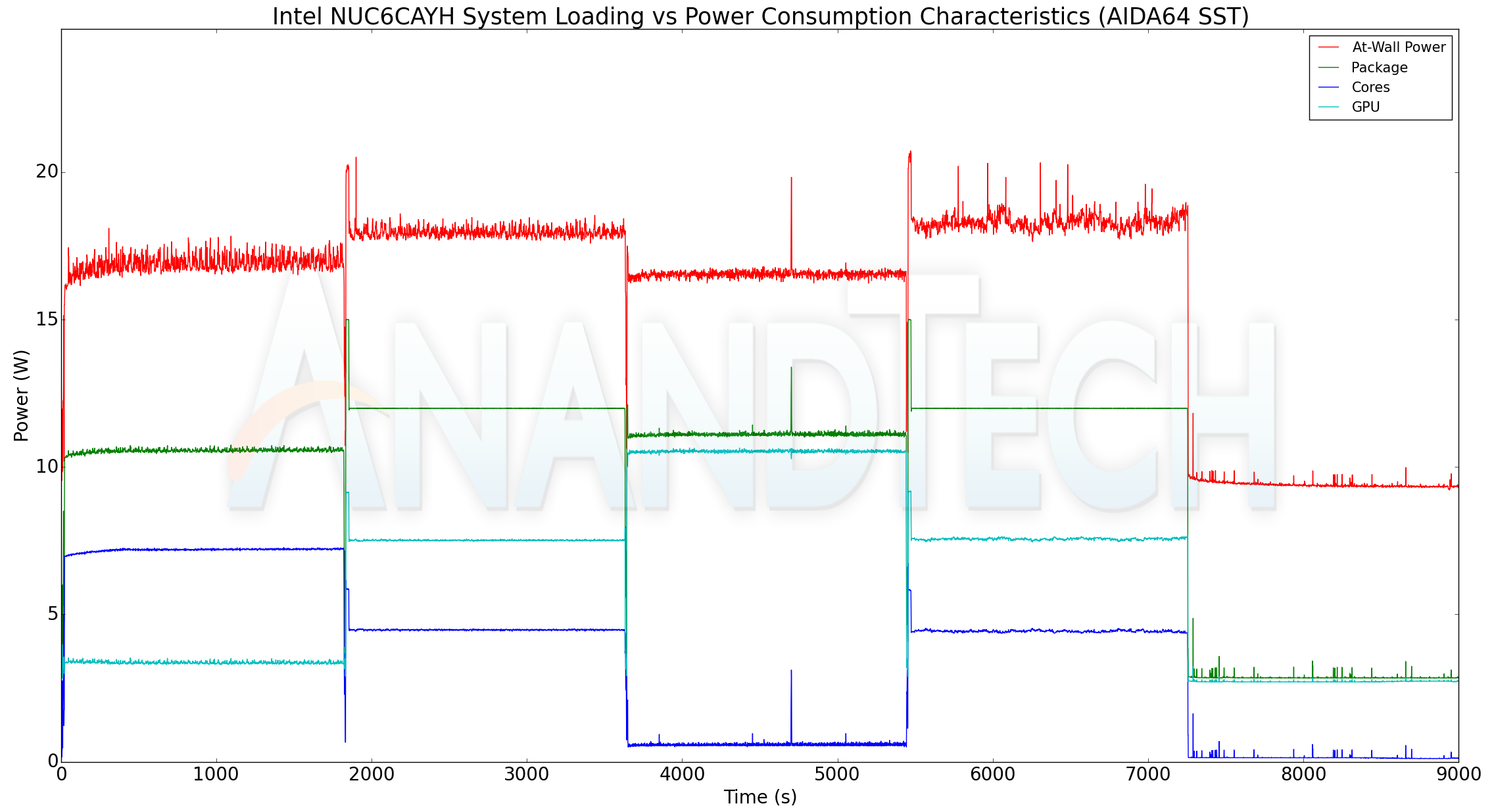Intel NUC6CAYH (Arches Canyon) Apollo Lake UCFF PC Review
by Ganesh T S on January 12, 2018 8:00 AM EST- Posted in
- Systems
- Intel
- NUC
- UCFF
- Apollo Lake
- Arches Canyon
Power Consumption and Thermal Performance
The power consumption at the wall was measured with a 4K display being driven through the HDMI 2.0 port. In the graphs below, we compare the idle and load power of the Intel NUC6CAYH with other low power PCs evaluated before. For load power consumption, we ran the AIDA64 System Stability Test with various stress components, as well as our power virus test, and noted the maximum sustained power consumption at the wall.


The Intel NUC6CAYH has a powerful CPU that wins in a majority of the presented benchmarks. But, it comes with a significant power penalty, both at idle and full loading.
Our thermal stress routine starts with the system at idle, followed by four stages of different system loading profiles using the AIDA64 System Stability Test (each of 30 minutes duration). In the first stage, we stress the CPU, caches and RAM. In the second stage, we add the GPU to the above list. In the third stage, we stress the GPU standalone. In the final stage, we stress all the system components (including the disks). Beyond this, we leave the unit idle in order to determine how quickly the various temperatures in the system can come back to normal idling range. The various clocks, temperatures and power consumption numbers for the system during the above routine are presented in the graphs below.
| Intel NUC6CAYH - AIDA64 System Stability Test | |||

According to the official specifications of the Intel Celeron J3455, the junction temperature of the SoC is 105C. We do not see the numbers go anywhere that in the AIDA64 SST processing of the system. Interestingly, the package power seems to be configured for around 12.5W instead of 10W (as dictated by the TDP).
The AIDA64 system stability test uses real-world workloads to stress the system components. However, power virus tests such as the Prime 95 torture test and Furmark stability test can subject the system to greater stress. We repeated our thermal stress routine with 30 minutes of Prime 95 (v29.1), followed by 30 minutes of Prime 95 and Furmark (1.19.1). The Prime 95 load was then removed, and the GPU stressing Furmark test was allowed too run for another 30 minutes. The various clocks, temperatures and power consumption numbers for the system during the above routine are presented in the graphs below.
| Intel NUC6CAYH - Custom System Stability Test | |||

Here, we see the temperatures going up to 100C, but there is no throttling involved. Peak sustained power consumption numbers are also higher than what we encountered in the AIDA64 system stability test.










54 Comments
View All Comments
Hulk - Friday, January 12, 2018 - link
Would it be possible to note the processor in the comparison systems in parenthesis for those of us who don't remember which system has which processor? Also it would be nice to have a fast processor in the metric (7700k or something like that) to get a gauge on how these low power processors compare.MattMe - Friday, January 12, 2018 - link
I agree with your points. Perhaps a U series would be a better comparison than a K series though?ganeshts - Friday, January 12, 2018 - link
I will keep that in mind for the next review.mode_13h - Monday, January 15, 2018 - link
The i3 from the BAPCo SYSmark seemed a good basis for comparison. Or maybe just the next more expensive NUC, in case someone is trying to decide whether to spend the extra money.Mr Perfect - Friday, January 12, 2018 - link
As an aside, does NUC packaging still come with the little light activated speaker that plays the Intel chime when you open the box? The first gen ones did, and I hid the speaker modules around the office so random things would chime when the light hit them. Good times...ganeshts - Friday, January 12, 2018 - link
Not in the new ones, unfortunately :)bi0logic - Friday, January 12, 2018 - link
won't this nuc be replaced by the June Canyon NUC(Gemini Lake) version any day now?intel says the NUC6CAYH launch was Q4 '16
https://ark.intel.com/products/95062/Intel-NUC-Kit...
ganeshts - Friday, January 12, 2018 - link
That is literally the last paragraph in my concluding section :)In any case, Intel plans to keep Arches Canyon in production till end of Q2 2018 as per official roadmaps.
mode_13h - Monday, January 15, 2018 - link
Still, I appreciate these benchmarks, since it should help show how much Gemini Lake (Goldmont +) actually improved.ilt24 - Friday, January 12, 2018 - link
Am I missing something? The $470 price with No OS seems quite high if the NUC starts at $130 and your just adding a pair of 4GB Memory modules and a 500GB SSD.